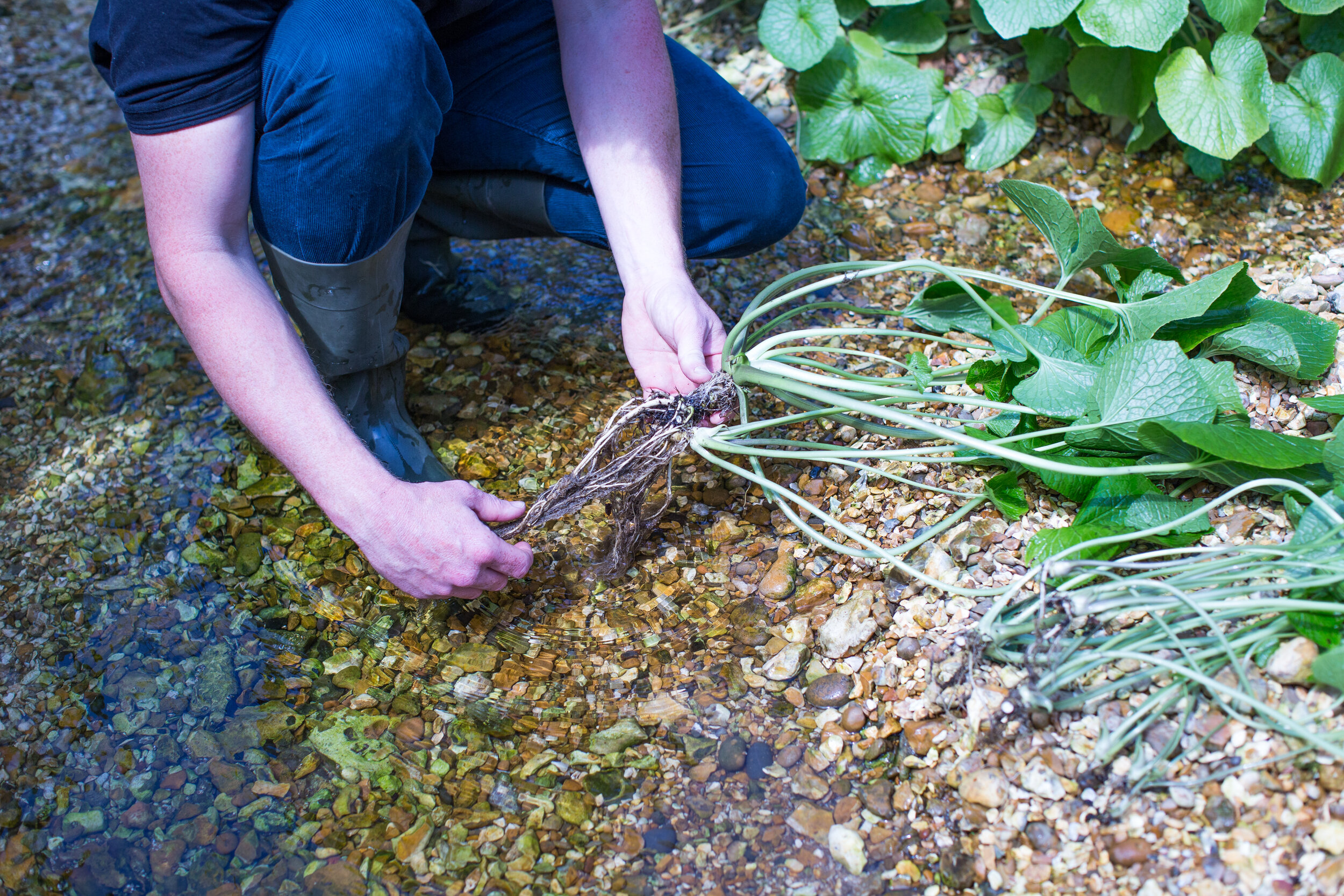Something to Write About
This week we hosted a very prestigious group of foodies when over 20 members of the Guild of Food Writers visited Alresford, Hampshire for a fascinating tour of Manor Farm watercress farm, Winchester Distillery a gin distillery which uses one very special botanical – you guessed it, watercress, and The Watercress Company’s sister business, The Wasabi Company the only growers in Europe of the plant with a kick like a mule – wasabi.
A rapt audience listened as MD of The Watercress Company, Tom Amery explained the sustainable methods used to grow watercress – no peat, no poly tunnels or pesticides in sight. He dipped into the history of watercress and how, over the years, our watercress has changed from a bronze red to the vibrant green we know today, but whatever its colour the same mineral rich water bubbling up from ancient underground aquifers has fed the same watercress beds for over 150 years.
After the opportunity to taste freshly picked watercress straight from the bed and to drink mineral rich water direct from the spring, the group went a few yards up the bank to try something a little bit stronger!
Winchester Distillery has been up and running for around 5 years and all the magic takes place in a building located on Manor Farm that was initially built to make elder flower champagne before becoming a packing house for watercress. With fresh watercress literally outside the door, Mark Ferguson explained to the gathered visitors, (now happily supping on a G&T), how watercress came to be the key botanical in the distillery’s primary gin, Twisted Nose. Not only did it provide the unique flavour but also its name; the Roman word for watercress Nasturtium comes from the Latin nasus tortus, literally meaning ‘twisted nose’ referring to the face Brutus et al pulled when they ate it!
Mark explained the process behind making gin and how the ‘big boys’ of the gin world had a stranglehold on the market until the removal of a minimum on the size of a still has allowed the recent explosion in craft gins. And talking of explosions, Mark also explained the origins behind ‘gunpowder gin’ with a strength of at least 57% ABV. In the days of wooden ships, cannon and gunpowder the officers’ supply of gin was stored alongside the gunpowder. Standard strength gin of around 47% ABV was found to prevent the gunpowder from lighting should it spill on it or the bottles of gin break on board ship. Rather than simply find somewhere else to store the gin, the Brits decided instead to make a stronger strength gin for the navy which still enabled the powder to ignite if it happened to spill on it!
Over lunch, the Guild members were able to explore the nutritious benefits of watercress as they feasted on a range of watercress fuelled dishes made by Mark Vaughan from a Brace of Butchers including of course, watercress soup, various quiches, scotch eggs, cheese & watercress scones and a rather popular watercress pesto, the recipe for which he has shared here.
While enjoying the food, registered nutritionist, Dr Lucy Williamson explained the different ways watercress aids the body and its functions plus the specific nutrients and vitamins for which watercress is a particularly rich source. So many benefits are there, that Lucy ran out of time and so The Watercress Company is offering The Guild of Food Writers the chance to join them on a webinar/webcast that will be interactive so the watchers can ask questions live via the closed broadcast. Participants will be sent samples of products to enjoy and to discuss the tasting notes together. If you’re a member and would like to take part, contact Sam Gates via the Guild.
After lunch came a mad dash cross country to visit Europe’s only Wasabi growers. With two farms in Hampshire and one in Dorset, The Wasabi Company has taken root in old watercress beds belonging to parent company, The Watercress Company.
Wasabi Company’s, Nick Russell explained how the watercress and wasabi businesses have very different business models as watercress grows rapidly with several harvests over the course of a season, while wasabi plants take at least two years to come to fruition. Both, however, thrive in flowing spring water and reap the mineral rich benefits of this water source.
nick shows the structure of a wasabi plant
Nick demonstrated how to ‘disarm’ one of the wasabi plants, explaining that while the leaves and stalks can all be used, the prize is the rhizome on which the leaves and new plantlets feed. It is the rhizome that is grated and pulverised into the pulp so highly revered around the world. Nick revealed that for many of us, our experience of wasabi, usually with sushi, is actually horseradish coloured green and that real wasabi is far superior. He wasn’t wrong! The freshly prepared wasabi he gave to try was much sweeter and smoother than many expected and actually changed its flavour profile over time, becoming hotter and more ‘punchy’ the longer it was left.
The price of wasabi means that it is unlikely to become available any time soon in our supermarkets but The Wasabi Company is supplying many top UK chefs so there is a chance to sample it on a night out. Not willing to take wait that long however, many of the Guild Members left The Wasabi Company clutching a wasabi plant and were last seen trooping down Winchester Station platform like a platoon of triffids!
All agreed it was a great day, informative, fun and very original as highlighted by the comments The Watercress Company received:
“Tom - I wanted to thank you and your team for what was one of my top Food Writers' events yesterday. I knew nothing about wasabi, apart from the fact it's really hot, so the learning curve was sharply upwards. And the watercress beds and the natural spring made for a really full and worthwhile day.”
I'll think about you all and the venue when I use watercress at home. Thanks so much for the generous goodie bag too
A very satisfied customer. Wendy G
“I was on the Guild of Food Writers trip yesterday and I just wanted to say a big thank you to you and your team for all your time, trouble and hospitality. It was so interesting to see both watercress and wasabi growing and learn so much about them. I've always loved watercress, so was very pleased to learn what a remarkably healthy plant it is and how you grow it so sustainably. The wasabi project is fascinating, too - and the contrast between the two crops made a really interesting day.”
All the best
Jenny
The Watercress Company would like to say huge thanks to everyone for coming and to the AHDB for helping to set up the visit.








